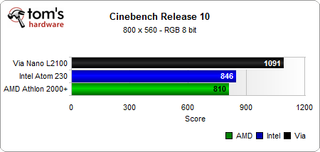Atom, Athlon, or Nano? Energy-Savers Compared
Benchmarks: Synthetic Benchmarks

Cinebench is a popular CPU rendering benchmark, which provides results we’ve already seen: VIA’s Nano L2100 is fastest, followed by the Intel Atom and AMD’s low-power interpretation of the Athlon 64 2000+.

PCMark05 is a synthetic benchmark, which doesn’t always reflect real-world performance. However, in case of the CPU benchmark, the results are in line.

The PCMark05 graphics score depends a lot on the graphics engine, and you can clearly see that the ATI engine in AMD’s 780G chipset is far superior, and that VIA’s DirectX9.0a engine that comes with the CN896 chipset does not offer great performance. All of this doesn’t matter for typical low-power applications, though.

The memory benchmark is always influenced by cache performance. It requires a quick memory controller, which may be the reason for the Athlon 64 2000+’s slow performance—the 1-GHz core clock speed limits the L2 cache performance as well as the performance of AMD’s integrated memory controller despite DDR2-800 speed.

The total score in PCMark05 includes graphics and memory performance and hence provides a balanced picture. The AMD system in fact offers better graphics performance than the two others; Intel offers the best memory performance and VIA dominates only in the CPU score, which brings it close enough to the others to remain comparable.
Stay On the Cutting Edge: Get the Tom's Hardware Newsletter
Get Tom's Hardware's best news and in-depth reviews, straight to your inbox.
Current page: Benchmarks: Synthetic Benchmarks
Prev Page Benchmarks: Applications Next Page SYSmark 2004 and Power ConsumptionMost Popular

